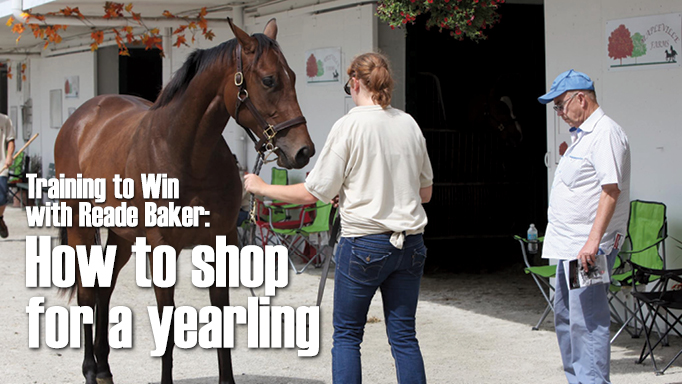The dilemma when looking at, and shopping for, Thoroughbred yearlings is where or when do you take a stance and when do you not. Buying an unbalanced, nonathletic horse is a no-no. So, let’s take a look at some of the finer points I consider when looking at yearlings.
It’s all about balance when it comes to yearlings
When looking at a horse from the side, you must insist on balance. You want to make sure all the parts, such as the neck and back, are of equal length and strength. You want these parts to flow into each other. A horse with a big hip, for example, means that he’s not full in the rest of his body. One with a short neck could send the horse out of rhythm. That’s an unbalanced horse. Big long neck and, long bodies, I find 90 per cent of those may develop throat problems.
When viewing the horse walking from the side, he should look like a country boy walking home from the store. The horse should have a big, long forward stride and look like he’s enjoying it. When you watch him walk from the front (head on) and from the back (walking away from you) you want his stride to be fluid and straight.
Remember the horse’s gallop will be a simple and direct multiplication of the walk. It is folly to ask them to jog; the walk is the key. Most strong deviations from a straight-forward walk will end up in unsoundness.
Make sure that during the walk, when they make the sharp turn to walk back toward you, they make that hard turn gracefully and effortlessly. If he can’t do that then the horse is not athletic.
Most trainers back away from a small horse. I don’t. I find that horses with big joints, big feet, or a hind end that sticks up are the ones that can’t make that tight turn when they are being walked for you back and forth; they are awkward and stumble.
Finally, the horse should be eager to obey the handler and inquisitive of the new surroundings. He is going to have to be able to cope with these situations multiple times at the track from the paddock to the gate to the races.
Vetting is key when buying young horses
The agent selling the horse will have great stories about why this horse acts differently than the others. Some of these tales are amusing. They are usually pushing horses that are not getting much attention.
You must have a horse you like vetted. I won’t take a horse for free unless I have him vetted. The best idea is to hire a vet with racetrack experience or, better yet, hire your own vet to look at x-rays, conformation and scope them.
You want to know about anything on the x-rays, anything the vet notes. There are about 30 areas the x-rays show and you rely on your vet to point out what is worrisome. If a yearling has a chip or flake – from galloping around a field – I would be worried how well-made he is.
At the sales you could have 100 horses to look at in a morning. If you start looking at all the little things you won’t have time to see them all. You’ve only got a few minutes to look at horses. If you see a horse that looks athletic and passes your initial impression, go and have him vetted. You don’t want to find out seven months later that he has bone issues.
Spend the money to get them vetted, it’s the least amount of money you will spend that day.
Forgiveables and purpose for your young horse
There have been a couple of times I’ve gone against my own rules and it’s worked out.
I bought a horse named Solidify at Keeneland September for $15,000. You could not get him to stand still at the sale but I was willing to forgive that. He was hard to handle before we gelded him but he became a lovely horse after.
Fatal Bullet, a $27,000 purchase, paddled badly on the jog and was one of those situations where I chose to forgive a conformation flaw. The walk is duplicated in the gallop, not the jog and he didn’t paddle when he walked. He became Horse of the Year.
I would council not to have too many restrictions as a buyer otherwise you lessen the chance of getting a good horse. It’s tough enough to get value for your dollar without adding extra considerations.
The only type of restriction I can work with is if someone said, “My only objective would be to win the Queen’s Plate” so you can eliminate all the horses who look like sprinters. Anything more restrictive than that just makes a tough job more difficult.
Thoroughbred pedigree
The pedigree is there for everyone to see in the catalogue and will dictate the price of the horse. That said, if I have $20,000 to spend I will give up pedigree before I give up my other parameters.
I do take note of the age of the mare as older mares do not produce as many stakes winners as young mares. I also like to look at yearlings from proven stallions that are unfashionable. Anything fashionable in the pedigree is going to cost more.
I do like to see good unrestricted earnings in a horse’s pedigree. I want more of that than restricted earnings.
If you see me at the sale don’t hesitate to ask me for a refresher course.


